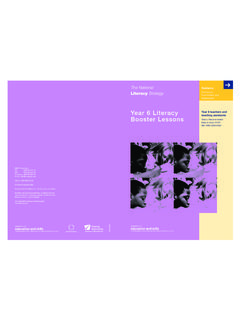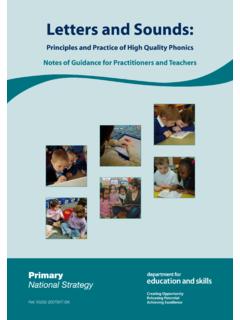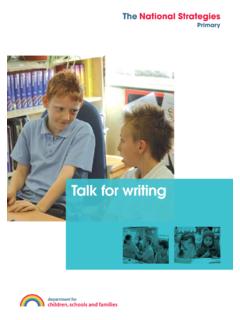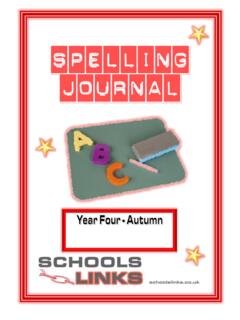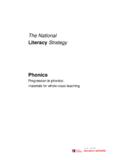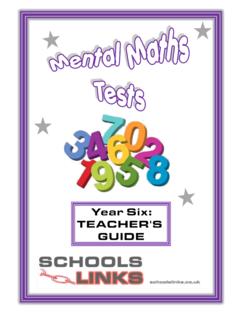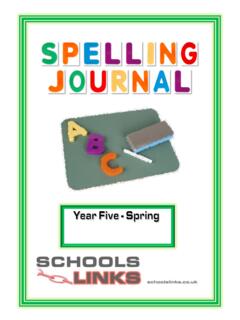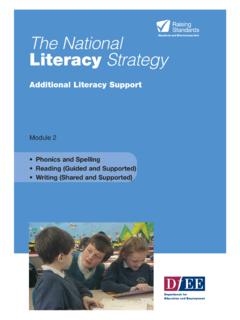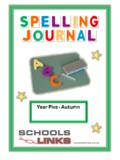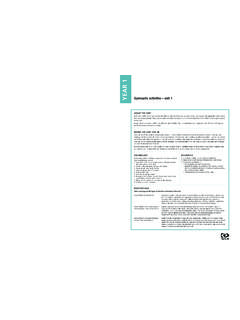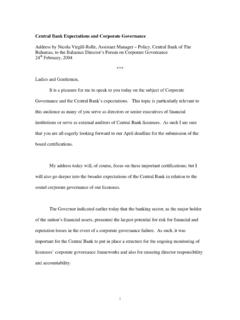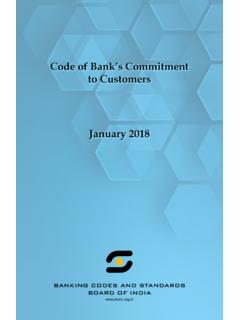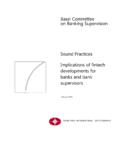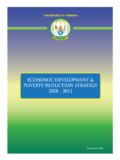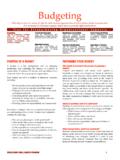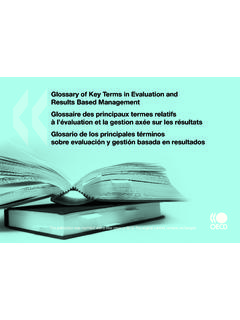Transcription of The National - schoolslinks.co.uk
1 The National Literacy Strategy Spelling bank Lists of words and activities for the KS2 spelling objectives Contents Page Introduction 3. Year 3 Term 1 objectives 4. Year 3 Term 2 objectives 8. Year 3 Term 3 objectives 16. Year 4 Term 1 objectives 21. Year 4 Term 2 objectives 28. Year 4 Term 3 objectives 31. Year 5 Term 1 objectives 40. Year 5 Term 2 objectives 45. Year 5 Term 3 objectives 52. Year 6 Term 1 objectives 58. Appendix 1 Spelling around the clock 60. Appendix 2 Teaching spelling conventions 61. Appendix 3 Examples of investigations 62. Appendix 4 Differentiation issues 70. Appendix 5 Whole-class consolidation activities 71. Appendix 6 Spelling journals 76. Department for Education and Employment Sanctuary Buildings Great Smith Street London SW1P 3BT. Crown copyright 1999. Extracts from this document may be reproduced for non-commercial educational or training purposes on condition that the source is acknowledged.
2 2 ISBN 0 19 312240 5. National LITERACY STRATEGY. Introduction This booklet contains lists of words and ideas to help in the teaching of the Key Stage 2 spelling objectives set out in the National Literacy Strategy Framework for Teaching. They are drawn from the Word Level strand, predominantly from the section entitled Spelling Rules and Conventions', but with a few from the Vocabulary Extension' objectives . A page is devoted to each individual objective, although there are obvious links between objectives , particularly those covering prefixes, suffixes, roots and modified endings. To ensure a smooth incline in learning, you will find it useful to look at examples from previous and later year groups to see how these strands develop. The word lists are not exhaustive; they have been selected as the most common and appropriate words for the age group, and the most useful for teaching.
3 Families of words have been represented by a single word rather than listing every variation. Some objectives are revisited or, more accurately, approached from different angles. For example, the choices involved in putting s onto the end of a word are tackled as part of pluralisation, tense and the use of suffixes. This is a deliberate attempt to anchor key rules securely. For each objective you will find not only a bank of useful words, but suggestions for teaching the objective in whole-class and group time. At the bottom of each page you will usually find notes which include the rules or conventions themselves. For more specific ideas and lesson materials, look in the orange National Literacy Strategy booklet for Module 2 Word Level Work: Activity Resource Sheets'. For information, call 01536 741171 or visit our web site at This booklet is issued as an extra support to the National Literacy Strategy training materials for 1999 2000, which include a hour session on spelling for each year of Key Stage 2.
4 Contact your Local Education Authority's Literacy Consultant/s for further details. Extracts from the training which may prove useful have been provided in the Appendices. 3. National LITERACY STRATEGY. Year 3 objectives Year 3 Whole-class approaches Collect up a list of ing words and their base words to compare. Investigate Term 1 the effect of adding ing to the words in the ending in e' and short vowels'. lists. Provide some base words and ask children to add ing on individual Objective 8. whiteboards to show you. How the spellings of verbs alter when ing is Group task added Card-sorting activities. Extension activity (very challenging). Add ing to words ending in c (add in a k);. vowel + y (just add);. l (double the l). Typical words Words ending in e Words with short vowels help helping hope hoping hop hopping ask asking take taking run running see seeing write writing shut shutting do doing drive driving chat chatting spend spending decide deciding clap clapping go going make making shop shopping enjoy enjoying care caring plan planning lead leading stare staring rub rubbing pull pulling hate hating slip slipping look looking like liking fit fitting jump jumping smile smiling tip tipping meet meeting come coming bet betting say saying ride riding win winning try trying amaze amazing sit sitting walk walking raise raising slim slimming Notes Most words just add ing.
5 Words ending in e drop the e to add ing. Words with a short vowel before the final letter double the final letter. 4. SPELLING BANK. Year 3 Whole-class approaches Collect a list of le words over time, from shared text or by brainstorming. Term 1 Investigate the list for familiar patterns, particularly for the letters that tend to precede the le. Experiment in adding suffixes such as ly, ing, and draw attention to the Objective 9. dropping of the e. To investigate and learn to use the spelling Group tasks Sort the list of words into family groups, those preceded by double pattern le as in little, letters, those preceded by ck, etc. muddle, bottle, scramble, Word-hunt for more examples. cradle Word-hunt for el and al words. ckle able Double letter + le cle dle chuckle able middle ripple uncle candle prickle table giggle nettle article handle tickle vegetable guzzle bottle cycle needle cackle fable toggle muddle icicle noodle trickle cable kettle hobble obstacle poodle pickle reliable cattle puddle miracle bundle probable stubble cuddle circle little wriggle particle bubble rubble cubicle apple nozzle bicycle ripple sizzle saddle wobble paddle fiddle ble ible ple double sensible example trouble responsible dimple bible possible simple fable horrible crumple humble terrible ample tumble sample grumble rumble Notes le is much more common than el or al.
6 It is easy to distinguish between cel and cle because the c is always soft in the former and hard in the latter. (Compare parcel and particle). The vast majority of le endings are preceded by letters which feature an ascender or descender. al words include pedal, metal, cannibal, medal, petal, and the al suffix appears in words like medical and magical. el was originally a suffix meaning small. Examples include satchel, label, model, angel, parcel, quarrel, cancel, excel, channel, funnel and tunnel. There are a huge number of other le words which are part of a split digraph, sale, tale, whole, mile, etc. These have been excluded from the list. This particular le ending does not produce an extra syllable in the way it does in the list above. 5. National LITERACY STRATEGY. Year 3 Whole-class approaches Use magnetic letters to form prefixes for pre-written words on whiteboard.
7 Term 1 slide them into place and ask how the prefixes have changed the meaning of the words, and what the prefix means. Make sets of prefixes and words, hand them out and get children to find a Objective 10. partner'. Break the pairs and ask them to find new partners. Each child keeps a note of words created until they have done as many as they can. To recognise and spell Compare lists. common prefixes and Generate words using the same prefix. how these influence word meanings, un, de, dis, re, pre Group tasks Play Kim's game using 30 assorted word cards from the list below, children hunt for pairs in turns and use checklist for answers. Investigate other prefixes, working out the meaning of the prefix. Extension activities Play Definitions game children provide a definition and challenge the class to find the right word. Find words using the letter sequence but not as a prefix, disturb, devil, read, preach and uncle.
8 Un de dis re pre unable demist dishearten rebound precaution unwell deform dislike rebuild predict unhappy decamp dislodge recycle previous untidy decode disown recall premature untrained defuse displease refill preface unlucky deflate disqualify reform prefix unpopular debug disappoint retreat prepare unpick de-ice disagree recede unseen decompose disappear return unusual disconnect replace undo dishonest revisit untie disinfect replay unzip disembark rewrite unofficial disobey repay Notes The word prefix has the prefix pre, and can help in your definition. un means not'; de means making the opposite of '; dis means not', the opposite of '; re means again'; pre means before'. A hyphen sometimes appears between the prefix and the word, de-ice. 6. SPELLING BANK. Year 3 Whole-class approaches Write pairs of words (happy/unhappy) in random order on the whiteboard Term 1 children sort and define how the antonym has been created.
9 Play Make an Antonym game, using flashcards from the lists of words without prefixes below. Objective 11. Place Post-It notes over prefixes in antonyms in shared texts ask children to work out the appropriate choice, or hold up correct prefix from a To use their knowledge selection. of prefixes to generate new words from root words, especially Group tasks Play Kim's game place cards upside down and hunt out the pairs of words antonyms, and their opposites. happy/unhappy, Using prefixes covered so far, have the children select one and write down appear/disappear an antonym three pairs of children in a group in a Beat-the-Clock activity. Extension activities Children select an antonym, then come up with synonyms unhappy, miserable, depressed; unseen, invisible, camouflaged. Children prepare dominoes antonym one side, synonym on the other to be used by other groups. un dis others well unwell appear disappear sense nonsense tidy untidy arm disarm stick non-stick usual unusual agree disagree fiction non-fiction certain uncertain approve disapprove clockwise anti-clockwise friendly unfriendly connect disconnect frost defrost do undo honest dishonest compose decompose able unable like dislike place misplace selfish unselfish please displease behave misbehave seen unseen qualify disqualify possible impossible kind unkind allow disallow probable improbable pleasant unpleasant comfort discomfort regular irregular popular unpopular trust distrust legal illegal happy unhappy order disorder sensitive insensitive fair unfair obey disobey visible invisible lucky unlucky continue discontinue convenient inconvenient Notes Just add the prefix a no-nonsense rule.
10 This accounts for the double n in unnecessary and the double s in dissatisfied. Useful for handwriting practice. Stressing the meaning of prefixes is a support for spelling and vocabulary. 7. National LITERACY STRATEGY. Whole-class approach Identify words ending in er and est in Shared Reading/Writing show Year 3 how changing the suffix changes the meaning. Term 2 Group tasks Play a matching game base words have to be paired with suffixes. Objective 8 (1 of 2) Position additional function cards ( Take away the final e') between base words and suffixes where appropriate. How words change Investigation find words that end with er and est and group them when er and est are according to the spelling rule. added Extension activities Find exceptions, good, better, best; bad, worse, worst; far, farther, farthest. Investigate the use of more and most, more curious, more intelligent, more sensible.
